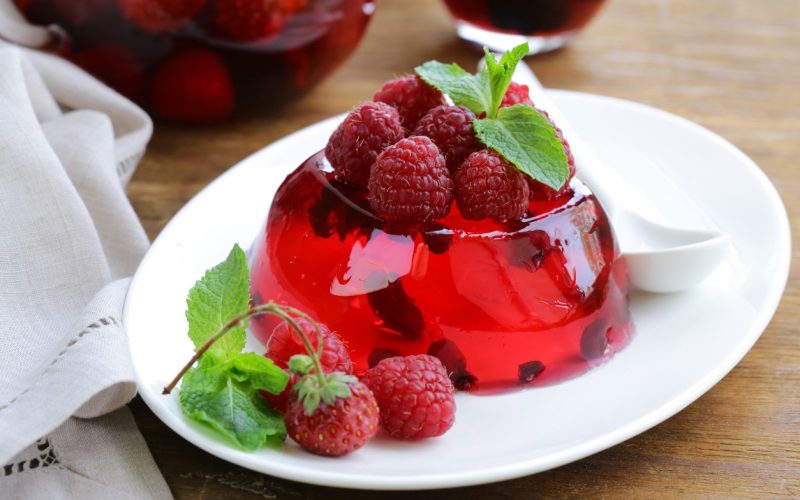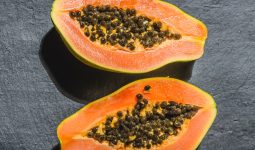Gelatin, which comes from animal skin and bones, has traditionally been used as an ingredient in desserts such as Jello and custard pies.
However, there has been controversy over the ethics of eating animal products in recent years. Luckily, some substitutes for gelatin can serve the same functions in cooking, whether used to thicken liquids or set desserts and puddings.
Moreso, the best substitutes for gelatin are made from vegetable-based materials like pectin and agar. Although tapioca starch also works well for desserts.
Above all, we’ve got the list of the best substitutes for gelatin here. Let’s surge!
1. Agar Agar
One Green Planet claims that agar-agar, commonly known as Kanten or just agar, is made from Red Sea algae.
And that it is one of the most well-liked (and efficient) vegan substitutes for gelatin. Like gelatin, it has no flavor, color, or aroma and can thicken or firm up your unstable sweets.
Meanwhile, Agar-agar performs better than gelatin under high temperatures. But it firms up a little thicker than gelatin, so your Jell-O might not be as wobbly as you wish. Agar-agar is available in flake, bar, and dry powder form, similar to gelatin.
Usually, you can get it in the grocery store’s international or health food section. In addition to that, you can use agar-agar as a substitute for gelatin. When you are cooking with agar-agar, it’s important to remember that it is not like gelatin.
As a result, it will not gel when cold and should be cooked at a higher temperature than usual. To substitute for powdered gelatin, dissolve agar-agar in water or broth.
2. Kudzu
Kudzu is a plant that has been used in Japanese cooking for centuries. It’s most often used as a thickener because it’s high in starch, which can be turned into a gel when heated and mixed with water.
Unlike other substitutes for gelatin, kudzu has no flavor, so you can use it in savory or sweet dishes without changing the flavor of your dish.
Kudzu is also gluten-free, making it an ideal substitute for those with celiac disease or gluten sensitivities.
3. Pectin
According to Food Network, pectin, which comes from fruits and vegetables, is frequently used in jams, jellies, and preserves as a binding and gelling agent.
Pectin is a starch that may be bought in dry or liquid form and is available in two types: high methoxyl and low methoxyl. Additionally, the first type is available in two variations: quick setting and slow setting.
The low methoxyl kind has a low sugar content; typically, it is only used for creating jam or jelly with little or no sugar.
The greatest results will typically depend on which of the kinds above you select when utilizing a recipe that asks for pectin.
Furthermore, Pectin is a substance found in fruits, vegetables, and grains, which has been used as a gelling agent for years.
It is extracted from citrus fruit, apples, or apricots. Consequently, it has several properties that make it one of the ideal substitutes for gelatin.
Some of those qualities are:
- Pectin contains fewer calories than gelatin – about 4% of the calories in pectin are from fat, and 100% of the calories in pectin are from carbohydrates.
- Pectin does not contain animal products, so if you have dietary restrictions or follow a vegan diet, this would be an excellent option.
- Pectins have natural preservatives that keep them from spoiling, whereas gelatin needs refrigeration after opening.
4. Vegan Jel
Look to vegan ”jel” as the simplest, most straightforward substitute for your typical box of powdered gelatin.
This product is available from a few different brands, and it’s essentially a gel dessert mix that is vegan and gluten-free.
Plus, it looks exactly like Jell-O unflavored gelatin, behaves exactly like Jell-O unflavored gelatin, and is packaged similarly.
Following the instructions on the box, you add the dry powder mixture to boiling water. Next, add it to your recipe and let it chill and firm up.
Vegan Jels are natural, vegan, kosher, and Halal substitutes for gelatin. It’s made from seaweed and is perfect for vegetarians and vegans alike.
There are so many different recipe ideas you can use it in too. You can find it at your local health food store or online!
5. Instant Clear Gel
Instant Clear Gel is a vegan alternative suitable for vegans, vegetarians, and those with food allergies. It has no taste or smell and dissolves easily in cold water. It’s great in sauces as well as gummy candies.
Instant Clear Gel, as one of the suitable substitutes for gelatine, is a versatile substance that can be used in various ways.
This includes using it as an ingredient in the following:
- Jellies and jams.
- Desserts, such as marshmallows and panna cotta.
- Sauces for meats or vegetables.
6. Xanthan Gum
Xanthan gum is one of the common substitutes for gelatin. It is made from the endosperm of corn, wheat, and soybeans.
It works well in both hot and cold foods. Also, it provides the same texture as gelatin but does not set as hard.
Besides, you will need less xanthan gum than you would with gelatin to achieve the desired consistency.
The disadvantages of xanthan gum are that it can be expensive and difficult to find. You will also need an additive called sodium hydroxide if you want your food to gel at all.
7. Cornstarch
Cornstarch is not left out of our list of various substitutes for gelatin. Additionally, it can be used in baking and cooking.
It has the same thickening power as gelatin but does not have the same taste or texture. Equally important to note is, Cornstarch is a powder with a gritty texture when mixed into liquids.
It will dissolve in cold water, but you need to add more heat and time if you want it to dissolve in hot water or other liquids.
8. Arrowroot Or Tapioca Starch
Arrowroot starch and tapioca starch are two alternatives for replacing the texture, flavor, and thickness of gelatin in recipes. They also bind ingredients together when cooking or baking.
We recommend a 1:1 ratio of arrowroot starch or tapioca starch with sugar, salt, and boiling water. Read on for more information on how to use these ingredients as gelatin substitutes!
9. Carrageenan
Though it is one of the substitutes for gelatin, it is not a perfect substitute. Carrageenan has been known to cause gastrointestinal inflammation. And the International Agency for Research on Cancer classified it as a possible human carcinogen.
Conclusion
Overall, seaweeds are probably the best substitutes for gelatin. It is a popular ingredient in Asian cuisine and is easy to find at many grocery stores. Algae, agar-agar, carrageenan, and pectin are good gelatin substitutes.
All in all, these ingredients can be found online or at natural food stores. Pectin is an especially good option because it doesn’t need refrigeration and can be purchased in a liquid or dry powder form.
If you’re following a vegetarian diet, it can be challenging to find recipes that use gelatin as an ingredient, especially if you’re making them for the first time.
Gelatin is used in many recipes to replace traditional gelatin due to its texture and pliability. Also, it can often be found in candy, jellies, marshmallows, puddings, and other sweets.
These simple tips will help you learn how to substitute gelatin from your favorite recipes.








